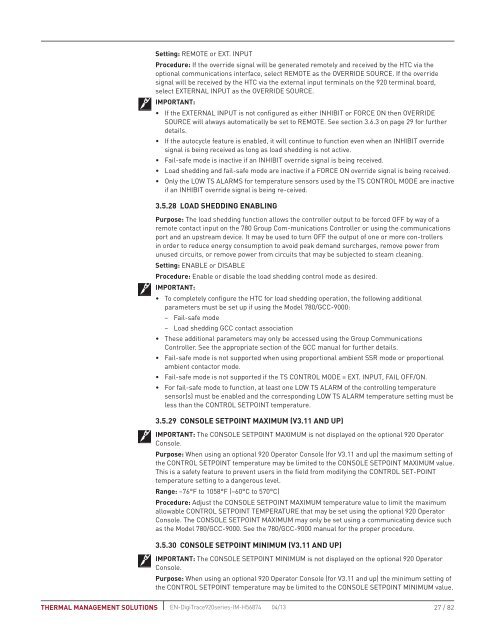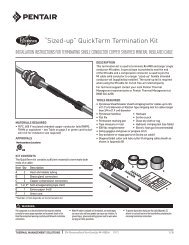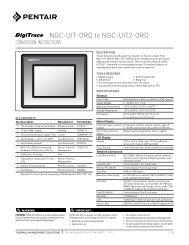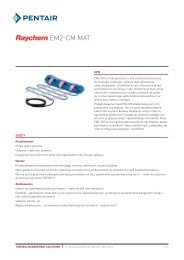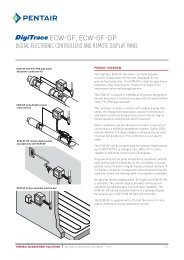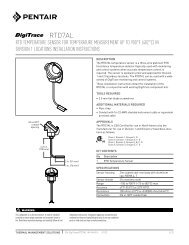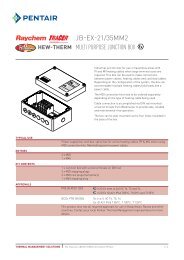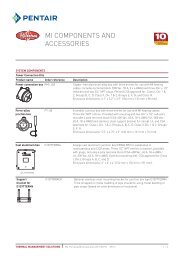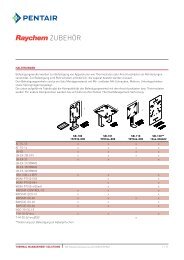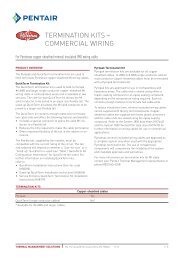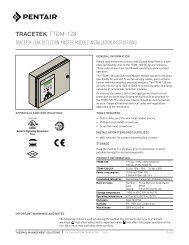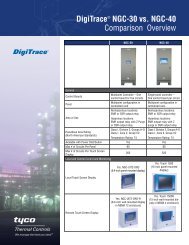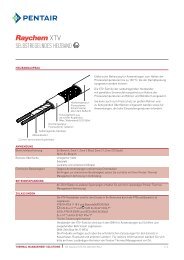DigiTrace 920 Series Heat Trace Controller - Pentair Thermal ...
DigiTrace 920 Series Heat Trace Controller - Pentair Thermal ...
DigiTrace 920 Series Heat Trace Controller - Pentair Thermal ...
You also want an ePaper? Increase the reach of your titles
YUMPU automatically turns print PDFs into web optimized ePapers that Google loves.
Setting: REMOTE or EXT. INPUTProcedure: If the override signal will be generated remotely and received by the HTC via theoptional communications interface, select REMOTE as the OVERRIDE SOURCE. If the overridesignal will be received by the HTC via the external input terminals on the <strong>920</strong> terminal board,select EXTERNAL INPUT as the OVERRIDE SOURCE.IMPORTANT:• If the EXTERNAL INPUT is not configured as either INHIBIT or FORCE ON then OVERRIDESOURCE will always automatically be set to REMOTE. See section 3.6.3 on page 29 for furtherdetails.• If the autocycle feature is enabled, it will continue to function even when an INHIBIT overridesignal is being received as long as load shedding is not active.• Fail-safe mode is inactive if an INHIBIT override signal is being received.• Load shedding and fail-safe mode are inactive if a FORCE ON override signal is being received.• Only the LOW TS ALARMS for temperature sensors used by the TS CONTROL MODE are inactiveif an INHIBIT override signal is being re-ceived.3.5.28 LOAD SHEDDING ENABLINGPurpose: The load shedding function allows the controller output to be forced OFF by way of aremote contact input on the 780 Group Com-munications <strong>Controller</strong> or using the communicationsport and an upstream device. It may be used to turn OFF the output of one or more con-trollersin order to reduce energy consumption to avoid peak demand surcharges, remove power fromunused circuits, or remove power from circuits that may be subjected to steam cleaning.Setting: ENABLE or DISABLEProcedure: Enable or disable the load shedding control mode as desired.IMPORTANT:• To completely configure the HTC for load shedding operation, the following additionalparameters must be set up if using the Model 780/GCC-9000:– Fail-safe mode– Load shedding GCC contact association• These additional parameters may only be accessed using the Group Communications<strong>Controller</strong>. See the appropriate section of the GCC manual for further details.• Fail-safe mode is not supported when using proportional ambient SSR mode or proportionalambient contactor mode.• Fail-safe mode is not supported if the TS CONTROL MODE = EXT. INPUT, FAIL OFF/ON.• For fail-safe mode to function, at least one LOW TS ALARM of the controlling temperaturesensor(s) must be enabled and the corresponding LOW TS ALARM temperature setting must beless than the CONTROL SETPOINT temperature.3.5.29 CONSOLE SETPOINT MAXIMUM (V3.11 AND UP)IMPORTANT: The CONSOLE SETPOINT MAXIMUM is not displayed on the optional <strong>920</strong> OperatorConsole.Purpose: When using an optional <strong>920</strong> Operator Console (for V3.11 and up) the maximum setting ofthe CONTROL SETPOINT temperature may be limited to the CONSOLE SETPOINT MAXIMUM value.This is a safety feature to prevent users in the field from modifying the CONTROL SET-POINTtemperature setting to a dangerous level.Range: –76°F to 1058°F (–60°C to 570°C)Procedure: Adjust the CONSOLE SETPOINT MAXIMUM temperature value to limit the maximumallowable CONTROL SETPOINT TEMPERATURE that may be set using the optional <strong>920</strong> OperatorConsole. The CONSOLE SETPOINT MAXIMUM may only be set using a communicating device suchas the Model 780/GCC-9000. See the 780/GCC-9000 manual for the proper procedure.3.5.30 CONSOLE SETPOINT MINIMUM (V3.11 AND UP)IMPORTANT: The CONSOLE SETPOINT MINIMUM is not displayed on the optional <strong>920</strong> OperatorConsole.Purpose: When using an optional <strong>920</strong> Operator Console (for V3.11 and up) the minimum setting ofthe CONTROL SETPOINT temperature may be limited to the CONSOLE SETPOINT MINIMUM value.THERMAL MANAGEMENT SOLUTIONS EN-<strong>Digi<strong>Trace</strong></strong><strong>920</strong>series-IM-H56874 04/1327 / 82


